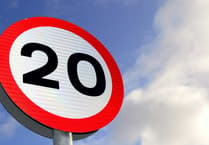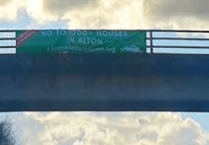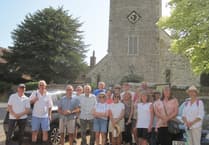Our family has a small treasure chest that was lovingly made by my father-in-law and filled with our collection of money from 53 countries going back half a century or more.
There are small plaques on the side reminding us of family holidays where adults enjoyed down time watching the children running around following clues, usually in the wrong direction. A parenting masterstroke. One occasion I vividly remember was down on the Helford River in Cornwall.
Everyone participated and got kitted out in pirate attire, complete with blow-up parrot and granny with a hook made from a sock and tin foil.
We set off in boats, first to plant the treasure then hunt it down. Great fun was had by all.
The key to any good treasure hunt is obviously a map with a great big X indicating ’ere be treasure.
Well, since writing April’s Chalk Balls walk, which includes two out of the 14 Andy Goldsworthy chalk stones up on the South Downs, I have been hunting a map showing where the remaining ‘treasure’ can be found.
Last week I finally found one, plotted a five-mile walk and set out with a friend to hunt down the giant orbs.
However, if you follow suit, keep in mind that the thrill of a treasure hunt is as much in the ‘chase’ as the actual discovery, so don’t be too disappointed if you don’t find them all, or the map proves inaccurate.
From Cocking Down car park on the Midhurst to Lavant road, head straight up to its name-sake above.
The most magnificent chalk ball of the whole trail staddles the junction at the top between the South Downs Way and a footpath off on the left.
The combination of the stone, view over Heyshott Down, and the weald below is simply stunning.
Taking the lower path continue until you reach a triangle of grass between paths. Here lurks number two. In contrast to the first, this one is very weathered and gently melting back into its natural chalky habitat, as planned by Goldsworthy.
Continuing on the right-hand track and keeping straight at the crossroads a short distance ahead, number three will soon appear.
Like the previous one, it is doing a good job of blending in. The junction is a good landmark, but it is hidden under a tree and has been decapitated by the cruel elements.
Gone are the tall, airy pines on this next section, instead the woods take on an increasingly Hansel and Gretel feel, closing in on both you and an old ruin, in a somewhat spooky way.
According to the map I found online, number four should be visible at the next big, open junction.
However, despite feverish hunting among the undergrowth, and quizzing local riders, it evaded us.
One for the winter months once the foliage has died back. Perhaps you will have better luck.
Turning left at this large junction, follow the track all the way down to the road, passing stones five and six on your way. These are the ones featured in the previous walk so may be familiar.
At the road, walk up the hill to be greeted by number seven.
This is very solid-looking. There are only a few shards on top providing local woodlice with a comfy home.
The onward path, direct to number eight, is to the right. This stone is nestled in the verge opposite where you join the tarmac.
The next part of the walk is along the road, but there is a walking area along this road.
It is a magnificent tree-lined avenue, no doubt with some connection to West Dean’s Edward James, that stretches idly and elegantly into the distance.
Walking in this direction you can easily pass number nine by, as it is tucked into a slight recess on the left-hand side and very overgrown.
After exiting the avenue, but just before the road bends and dips towards a cottage below, number ten is perched on top of the left-hand hedge.
After the cottage turn left into the woods and climb up the chalky track.
Along here you will find small, green number 11, and large, white number 12, illustrating what a difference location makes.
After passing some terrifically twisted yew tree trunks, the wood opens out into a wildflower meadow.
At the bottom of the hill, number 13’s location is clearly marked by the old railway bridge.
Through the arch and across the A286 you will be in West Dean College, where number 14 awaits you in parkland in front of the house.
Hopefully, you will find it easier to spot than us – we had the challenge of locating a creamy object hidden among a field of sheep.
Enjoy having reached your destination, and hopefully finding all 14 chalk stones along the way.
West Dean’s delightful gardens and café will keep you busy and refreshed while waiting for the number 60 bus back to Cocking car park.
If one or more stones eluded detection, I’m afraid it’s back to studying the treasure map for you.Malinka Van der Gaauw




